While many of the cities leading the resurgence in the popularity of biking are growing, Pittsburgh has found its own reasons for making the city a better place to bike.
“In the past few years, Pittsburgh has built 30 miles of on-street bike infrastructure and 500 bike racks, and it has started to install bike corrals,” reports Tanya Snyder. But those types of improvements haven’t occurred in the same conditions as growing cities like New York or Washington D.C.
“Remember, we’re a city that went through 40 years of population decline. So we’re not one of those cities that is booming and this is a necessity. We’re doing it in order to encourage bike-sharing as a program, in order to encourage less need of the use of a car, in order to encourage developers to not have to put in surface parking lots or dig down several feet and then ask for a TIF because they can’t afford the parking infrastructure they’re putting in,” explained Mayor Bill Peduto in a recent speech to the National Bike Summit.
According to Snyder’s article, Pittsburgh has made a lot of progress in improving bike infrastructure in the city, despite its less gilded economic and demographic history in recent decades: “At about the same time that Pittsburgh’s economy hit bottom, it was ranked one of the worst five cities in the country for bicycling…Now Bicycling Magazine rates Pittsburgh the 35th most bicycle-friendly city in America, and Peduto wants to see it shoot into the top ten. Thirty percent of Pittsburghers walk, bike, or take transit to work — only seven other American cities have a higher share.”
FULL STORY: Bill Peduto: If Pittsburgh Can Make Streets Bikeable, You Can Do It Anywhere

Maui's Vacation Rental Debate Turns Ugly
Verbal attacks, misinformation campaigns and fistfights plague a high-stakes debate to convert thousands of vacation rentals into long-term housing.

Planetizen Federal Action Tracker
A weekly monitor of how Trump’s orders and actions are impacting planners and planning in America.

San Francisco Suspends Traffic Calming Amidst Record Deaths
Citing “a challenging fiscal landscape,” the city will cease the program on the heels of 42 traffic deaths, including 24 pedestrians.

Defunct Pittsburgh Power Plant to Become Residential Tower
A decommissioned steam heat plant will be redeveloped into almost 100 affordable housing units.

Trump Prompts Restructuring of Transportation Research Board in “Unprecedented Overreach”
The TRB has eliminated more than half of its committees including those focused on climate, equity, and cities.

Amtrak Rolls Out New Orleans to Alabama “Mardi Gras” Train
The new service will operate morning and evening departures between Mobile and New Orleans.
Urban Design for Planners 1: Software Tools
This six-course series explores essential urban design concepts using open source software and equips planners with the tools they need to participate fully in the urban design process.
Planning for Universal Design
Learn the tools for implementing Universal Design in planning regulations.
Heyer Gruel & Associates PA
JM Goldson LLC
Custer County Colorado
City of Camden Redevelopment Agency
City of Astoria
Transportation Research & Education Center (TREC) at Portland State University
Jefferson Parish Government
Camden Redevelopment Agency
City of Claremont





























